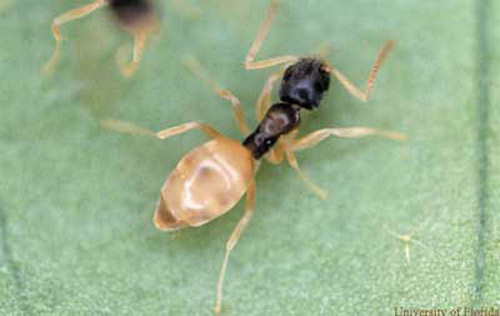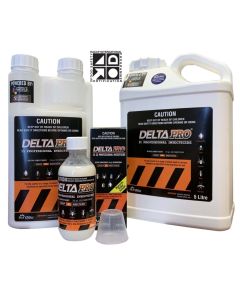Ghost Ant
- Article
- Ghost Ant
Ghost Ant
Scientific name: Tapinoma Melanocephlur
How to identify ghost ants?
Ghost ants are very small ants, the workers are 2mm long and have a pale, almost translucent abdomen and legs, hence the name. The head and thorax are a deep brown colour. The almost transparent body makes these tiny ants look even smaller again.

Where are ghost ants commonly found?
Ghost Ants tend to prefer warmer, wet habitats. Colonies are generally located outside but there are also colonies that set up home inside. Indoor Ghost Ants select their habitats based on their preference for warmth and high moisture requirements. Their trails often lead to sinks, baths, toilets and showers.
The nests are frequently located within wall voids, behind skirting boards, or in potted plant soil. Workers run rapidly and erratically, trailing along edges and corners.
Why are ghost ants considered a pest?
Ants are considered a pest when they infest buildings and surrounds, and feed on human foodstuffs.
What is the biology and lifecycle of ghost ants?
The life cycle of an ant consists of four stages: egg, larva, pupa and adult. Eggs are small and ovoid in shape. Fertilised eggs become females (usually sterile workers), but at certain times also fertile females (which can potentially become queens). Unfertilised eggs become males.The larva is a white grub with a narrow head. Adult workers feed the larvae and after sufficient feeding and several moults, the larva pupates. The pupa is similar in shape to the adult but is usually soft, white and inactive. In some species the pupa is protected by a silk cocoon. Once the adult emerges, its cuticle hardens and darkens. The development from egg to adult may take from six weeks to very long periods, depending on the species, season and food availability.
Management Tips For Ghost Ant
Effective control depends upon a number of factors:
-
The particular species involved,
-
The location of the nest site(s) and,
-
The degree of concern they are causing the occupants.
It may be easy to control a colony with a single queen (Camponotus spp), or difficult in the case of species with multiple queens and multiple “homes” and which do not display aggression to workers from other nests (Argentine ants, Odorous house ants and Pharaoh’s ants). That is why correct identification is essential before you begin your campaign.
Ant granules were perfect for the control of some ant species to exterior areas. Most insecticide manufacturers suggest that a two-pronged approach with both baits and liquid sprays be used in order to obtain best results. These manufacturers all supply bulletins with complete instructions on how to use their products. The product labels and these bulletins should all be studied before using any of the materials.
The basic rules for the use of baits are:
-
The basic premise is that bait should hopefully be consumed within 1 to 2 days when their palatability and moisture content are highest. The ants should die within 3 to 4 days.
-
Correct identification – by knowing the species, you can choose the right bait for the job and can also help you find their feeding, trailing and nesting sites.
-
Find the trails – you must place the bait where the ants are otherwise you are wasting time and bait. If the ants aren’t active at the time, you can pre-bait first with non-toxic foodstuffs. This will help you determine where the ants are feeding and what type of food they prefer.
-
Choose the correct bait formulation, they may prefer sweet foods or protein based materials. Sometimes the same species will change food preferences depending upon seasons or other conditions. Therefore, you need to have a range of baits in your kit bag. If you just put a small blob of each bait in the ant trails, you will very soon find which they prefer.
Some key rules to observe are:
-
Place the bait as close as possible to ant trails which are usually near feeding or nesting sites.
-
Place adequate amounts of bait out to ensure that they will continue to feed until your next visit. By placing the bait in purpose designed “ant cafes,” you will extend the life of the bait.
-
Avoid food competition by asking the client to remove available foodstuffs and liquids.
-
Avoid placing gel baits near sources of heat as the gel matrix may become liquefied and moisture loss may increase. Also, avoid placing them on dry or porous surfaces which may increase water loss and make them less palatable to ants.
-
Some baits lose their potency after only a few days exposure to sunlight. Make sure that you know which they are and replace them as required.
-
Some granulated baits lose their potency around three months after the container has been opened. Make sure that you write on the container the date on which it was opened.
-
A common piece of advice is that you mustn’t place baits on surfaces that have or will be treated with liquid or powder insecticides. Studies carried out by some researchers have indicated that this is not the case and the baits are still palatable. Some pest managers have stated, “Why waste money by applying two formulations?” and that is probably a good rule to live by. You may be able to control the ant problem without the use of insecticidal sprays and dusts but, all manufacturers recommend that bait applications are supplemented by the use of such formulations when treating free standing buildings. These insecticidal barriers will serve to prevent future ant activity to the interior.
The basic rules for the use of residual insecticide sprays are:
-
Non-repellent formulations are considered superior to repellent formulations e.g. synthetic pyrethroids, as the ants will track through the non-repellent insecticide unknowingly. Examples of non-repellent actives and formulations are Bendiocarb (Ficam), Fipronil (Termidor), Indoxacarb (Arilon), Chlorfenapyr (Phantom).
-
The sprays should be applied as a barrier to the base of foundation walls, fence lines and garden beds.
-
Re-application of the sprays may be necessary after rain.
-
Insecticidal dusts should be applied to roof voids where practical.
PRODUCT SOLUTIONS
-
 Maxforce Quantum Liquid Ant Bait (3 x 30g Pack)0.3g/L Imidacloprid
Maxforce Quantum Liquid Ant Bait (3 x 30g Pack)0.3g/L ImidaclopridMaxforce Quantum Liquid Ant Bait is a viscous liquid ant bait containing active ingredient 0.3g/L Imidacloprid. Ants take the bait back to the nest where the active ingredients kills the queen, workers and the rest of the nest.
-
 Coopex Dust Insecticidal Dusting Powder10g/kg Permethrin
Coopex Dust Insecticidal Dusting Powder10g/kg PermethrinCoopex Dust Insecticidal Dusting Powder is registered for the control of cockroaches, ants, fleas, silverfish and bed bugs in and around domestic and industrial premises, food preparation and storage areas. Also for control of mushroom flies in mushroom housing and bees in wall cavities.
-
 Antmaster Liquid Bait0.05g/L Imidacloprid
Antmaster Liquid Bait0.05g/L ImidaclopridAntmaster is a ready to use, sugar-based liquid bait for the control of certain ants. Contains a sweet food source in a low dose bait that is effective against most common pest ants in indoor and outdoor situations.
-
 Attractant PRO Ant Gel Bait 50g0.5g/kg Indoxacarb
Attractant PRO Ant Gel Bait 50g0.5g/kg IndoxacarbAttractant PRO Ant Gel is formulated for the control of major pest ants including Argentine ant, Black house ant, Coastal brown ant, Ghost ant, Hairy ant/Crazy ant, Pedicel ant, Pennant ant, Pharaoh’s ant, Red imported fire ant, Sugar ant.
-
 Optigard Ant Bait Gel0.1g/kg Thiamethoxam
Optigard Ant Bait Gel0.1g/kg ThiamethoxamOptigard Ant Bait Gel is an ant gel solution for professional pest controllers looking to deliver long-lasting, effective ant control. Designed for sugar-feeding ants, it not only targets visible infestations but eradicates entire colonies, including hard-to-reach queens. With its powerful formula and versatility, Optigard ensures your clients receive superior results in homes, businesses, schools, hospitals, and food preparation facilities.
-
 Delta Pro 25SC Professional Insecticide25g/L Deltamethrin
Delta Pro 25SC Professional Insecticide25g/L DeltamethrinFor the control of a range of insect pests such as spiders, cockroaches, flies, ants, mosquitoes in various situations.
-
 Advion Ant Gel0.5g/kg Indoxacarb
Advion Ant Gel0.5g/kg IndoxacarbAdvion Ant Gel targets most pest species of ants, including all key sweet feeders plus additional ant species. This is a highly attractive ant gel that locks in moisture for extended appeal to ants and uses active ingredient Indoxacarb.
-
 Clear Out Plus IGR Aerosol Insecticide 350g0.5g/kg Fipronil, 0.15g/kg Pyriproxyfen
Clear Out Plus IGR Aerosol Insecticide 350g0.5g/kg Fipronil, 0.15g/kg PyriproxyfenClear Out Plus IGR Aerosol Insecticide is a residual surface crack & crevice or spot treatment for control of ants, cockroaches and flies in domestic, commercial and public buildings.
-
 Starrdust PRO One-Shot Insecticidal Dust 400g20g/kg Permethrin, 5g/kg Triflumuron
Starrdust PRO One-Shot Insecticidal Dust 400g20g/kg Permethrin, 5g/kg TriflumuronThe Starrdust PRO One-Shot Insecticidal Dust 400g is an industrial-strength dust designed for use with the Starrdust PRO Duckbill Duster. It is a ready-to-use broad-spectrum insecticide with a unique formulation. It controls a wide range of insect pests including cockroaches, silverfish, spiders, ants, fleas, carpet beetles, bed bugs, European wasps, feral honey bees, bird mites, subterranean termites, hide beetles, millipedes, woodlice and clothes moths.
-
 Starrdust PRO One-Shot Insecticidal Dust 19 x 400g + Duckbill20g/kg Permethrin, 5g/kg Triflumuron
Starrdust PRO One-Shot Insecticidal Dust 19 x 400g + Duckbill20g/kg Permethrin, 5g/kg TriflumuronA convenient kit of 19 x Starrdust PRO One-Shot Insecticidal Dust 400g Pods and a bonus Duckbill Duster. StarrDust PRO is an industrial-strength dust designed for use with the Starrdust PRO Duckbill Duster. It is a ready-to-use broad-spectrum insecticide with a unique formulation. It controls a wide range of insect pests including cockroaches, silverfish, spiders, ants, fleas, carpet beetles, bed bugs, European wasps, feral honey bees, bird mites, subterranean termites, hide beetles, millipedes, woodlice and clothes moths.
-
 Taser Pro 800 WP Insecticide800g/L Bendiocarb
Taser Pro 800 WP Insecticide800g/L BendiocarbTaser Pro Insecticide is a residual broad spectrum non-repellent spray for the control of a wide range of insect pests in domestic, farm, agricultural, industrial, commercial and public service buildings.
-
 Tempo Residual Insecticide 1L25 g/L betacyfluthrin
Tempo Residual Insecticide 1L25 g/L betacyfluthrinTempo Residual Insecticide is a fast-acting, knock-down, broad-spectrum insecticide for general insect control in domestic and commercial situations, as well as for the control of pest insects of turf and ornamental plants.
-
 Killmaster Zero Pest Insecticide Strip 65g
Killmaster Zero Pest Insecticide Strip 65gKillmaster Zero Pest Strip is a highly effective, long-lasting solution for managing a wide range of flying and crawling insect pests, including cockroaches, moths, silverfish, ants, and flies. Designed for non-living areas such as storage spaces, store rooms, and industrial bins, this pest strip provides hassle-free protection for up to 4 months.
Out of stock
JOIN OUR NEWSLETTER NOW!
Be the first to hear about the latest specials, products, tips and ideas.

